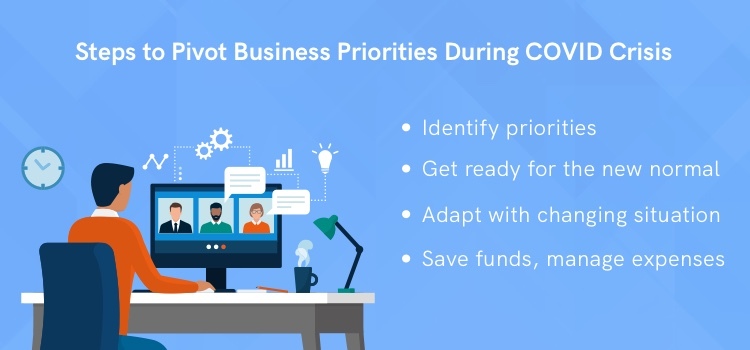How to Pivot Your Business Priorities in Rapidly Spreading COVID-19 Pandemic
Like all aspects of life in 2020, businesses throughout the world are in uncharted waters. Fortunately, successful businesses know how to adapt to change.. So, though the current situation is unprecedented, it is navigable if done so carefully and thoughtfully.
One of the most critical ways to adapt to major business change is to pivot your priorities quickly, but carefully. To help you get your business off to a good start, we have laid out the steps to pivot your priorities in response to the COVID-19 pandemic.
Step 1: Determine Priorities
There are two parts to step 1:
A. Determining what priorities will change.
B. Understanding the reasons why priorities will change.
Which priorities you decide to pivot in the wake of the pandemic is going to be a very individual choice based on your business needs. Very likely, you’ll look at these areas when considering which priorities you’ll want to change:
- Development
- Sales
- Marketing
- Pricing
- Product enhancements
- User experience
For instance, your growth strategies will most likely change dramatically. You may need your strategy to change from growing your business to grow your resilience to the economic downturn. Your sales and marketing will necessarily change to reflect how you can help your local community now so you can focus on doing what’s in the best interest of your neighbors. This strategy can come back to help you once it’s all over as well. Adjusting pricing and timelines for product enhancements and what the enhancements are may also need to be considered.
Reasons for pivoting your priorities may be similar to these factors:
- To minimize spendings
- To save jobs
- To automate processes
- The need to work from home
- To better allocate resources
- To increase morale and productivity
The coronavirus pandemic has resulted in the need for many businesses to cut corners in order to save money due to lost revenue. Lost revenue or reduction in workforces has also resulted in the need for more automation in existing processes. Plus, with much of the rest of the workforce staying home, there is a whole shift in priorities to make that happen. Making sure the resources you have been picking up the slack where necessary and utilized to their fullest extent are also important. Not to mention, people can have heightened emotions such as fear, annoyance, boredom, etc. Priorities will also need to be shifted in order to deal with morale and productivity issues.

Step 2: Prepare for the New Normal
None of us know exactly what the “new normal” is, but what we do know is that it will be different than the old normal. After this pandemic, the new normal will include ensuring your employees, clients, and vendors are able to adhere to recommended social distancing guidelines for as long as it is necessary.
For many businesses, working from home will not only be a temporary reality but maybe part of the new normal as businesses try to limit contact in offices. Some businesses are even exploring the possibility of closing their office altogether and having everyone continue to work remotely from here on out. Businesses such as Nationwide Insurance are permanently shifting to a remote workforce.
Moving more towards a digital economy is also possibly part of the new normal so that most parts of businesses will be run with technology. This was already a trend and now may end up being a necessity. Gov Tech states the reason for the initial trend is that technology continues to get cheaper, faster, and easier. Post-pandemic, the digital economy will help organizations recover from the economic impact.
Step 3: Adapt Your Brand
Your business does what it does, but no matter what it is, your brand should reflect what’s going on around us. There are easy ways to show you are in tune with your customers with a slight change in your brand language and imagery. For instance, evaluate your images and change any that show crowds of people, shaking hands, or people being too close together. It’s simply not a reality right now. Show the new reality with people gathering via conferencing apps and employees working from home. Take a look at your language as well, and determine if there is anything that does not reflect this new world.
Show customers you care as an organization by making sure they can stay healthy and safe with markers for appropriate distances to remain socially distanced or handing out face masks. Show them you feel their pain by practicing the same safety measures you ask of your customers. Help them out, if it’s possible, with free trials, discounts, or financing options. This adaptation in your brand can go a long way.
Step 4: Limit Spendings
Saving money is an important shift in priority. There are many ways to accomplish this. Plus, there are ways that Agile CRM and 500apps can help.
One safe way to save money is to find some alternative tools for your business at an affordable price. Affordable and time-saving tools can include:
- Marketing automation tools
- Project management tools
- Remote work monitoring tools
- Sales Management tool
- Human resources and recruitment management tools
- Entire suites of tools that can provide all of these at a reasonable cost
Agile CRM can help you automate your sales and marketing. Doing so will ensure your customer relationship management (CRM) is accessible anywhere allowing you to continue doing business. Focusing on tools that can help you get more done in less time and with implementing alternate working environments can help you avoid having to decrease hours, pay or workforce.
Conclusion
The good news is, the businesses that do change their priorities successfully and make it to the other side of this pandemic will be forces to be reckoned with. Hopefully, we’ll never see anything like this ever again, but, if we do, we will have a core of resilient businesses that will be perceived as strong and trustworthy.
Forbes suggests gathering data and evaluating results will be an important factor in being resilient in the face of a pandemic. Having the technology to do so will help you be more resilient. Turning data into actionable decisions on where to pivot your business priorities will take it a step further helping you and your business survive the rapidly evolving COVID-19 pandemic.

No Comments